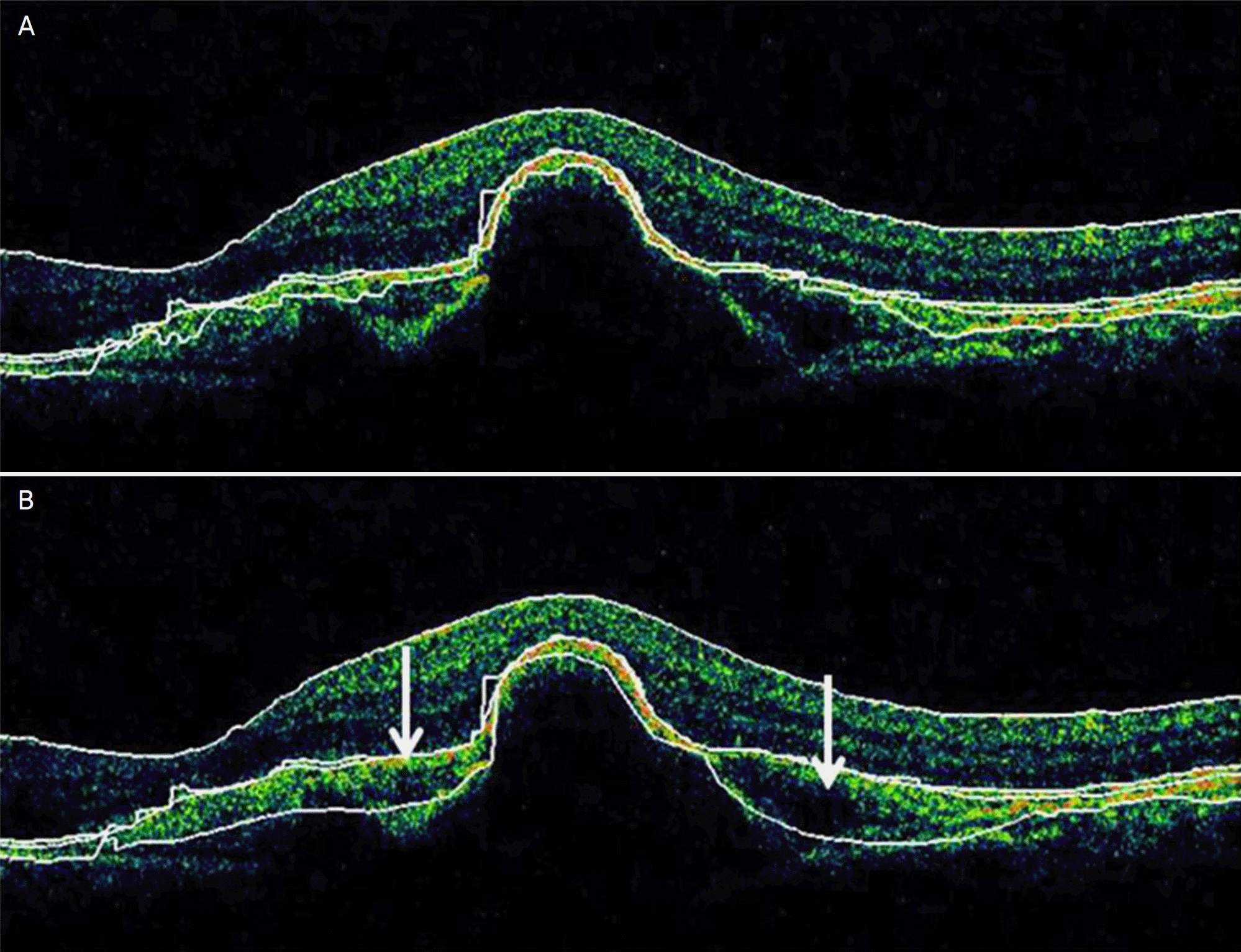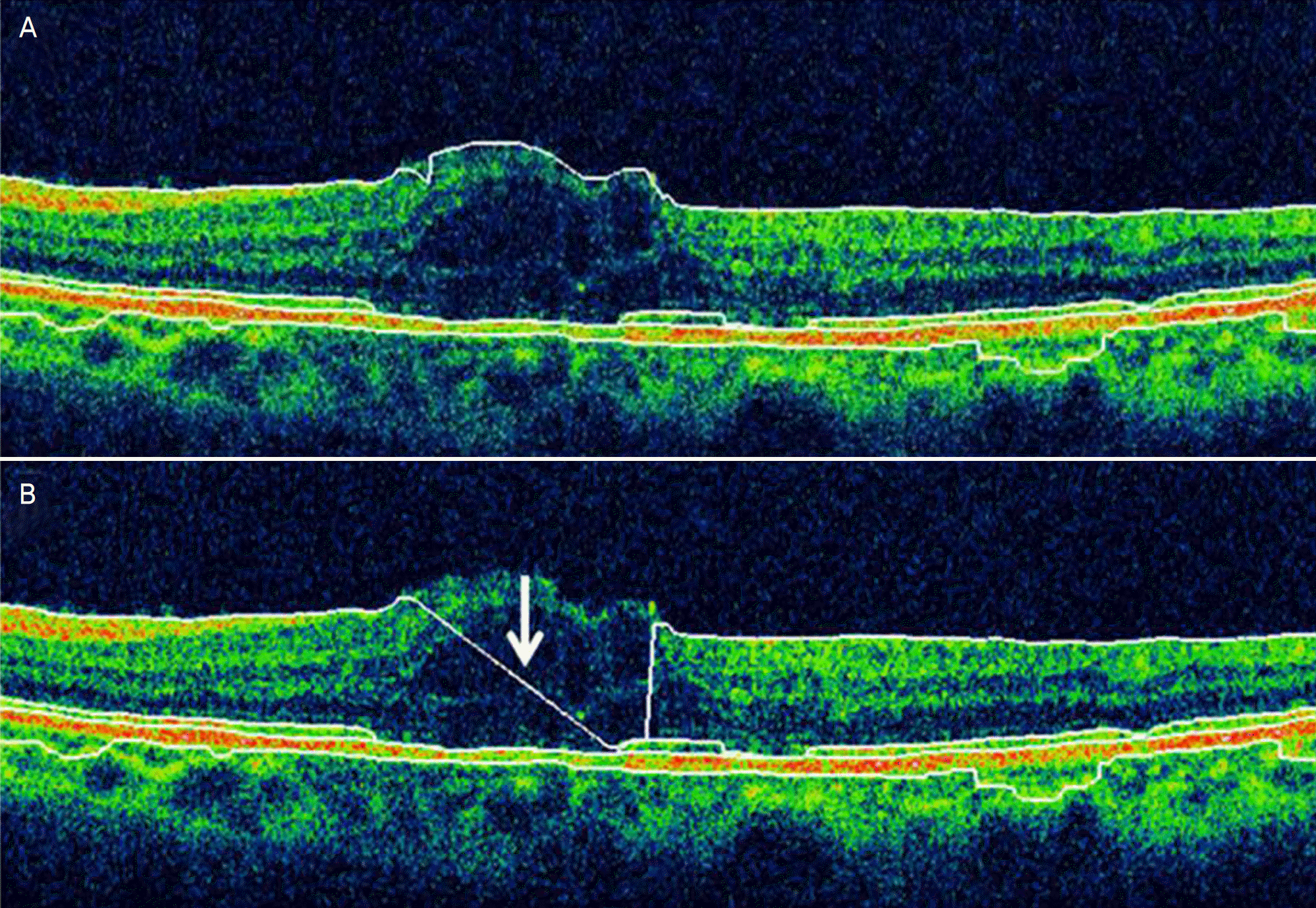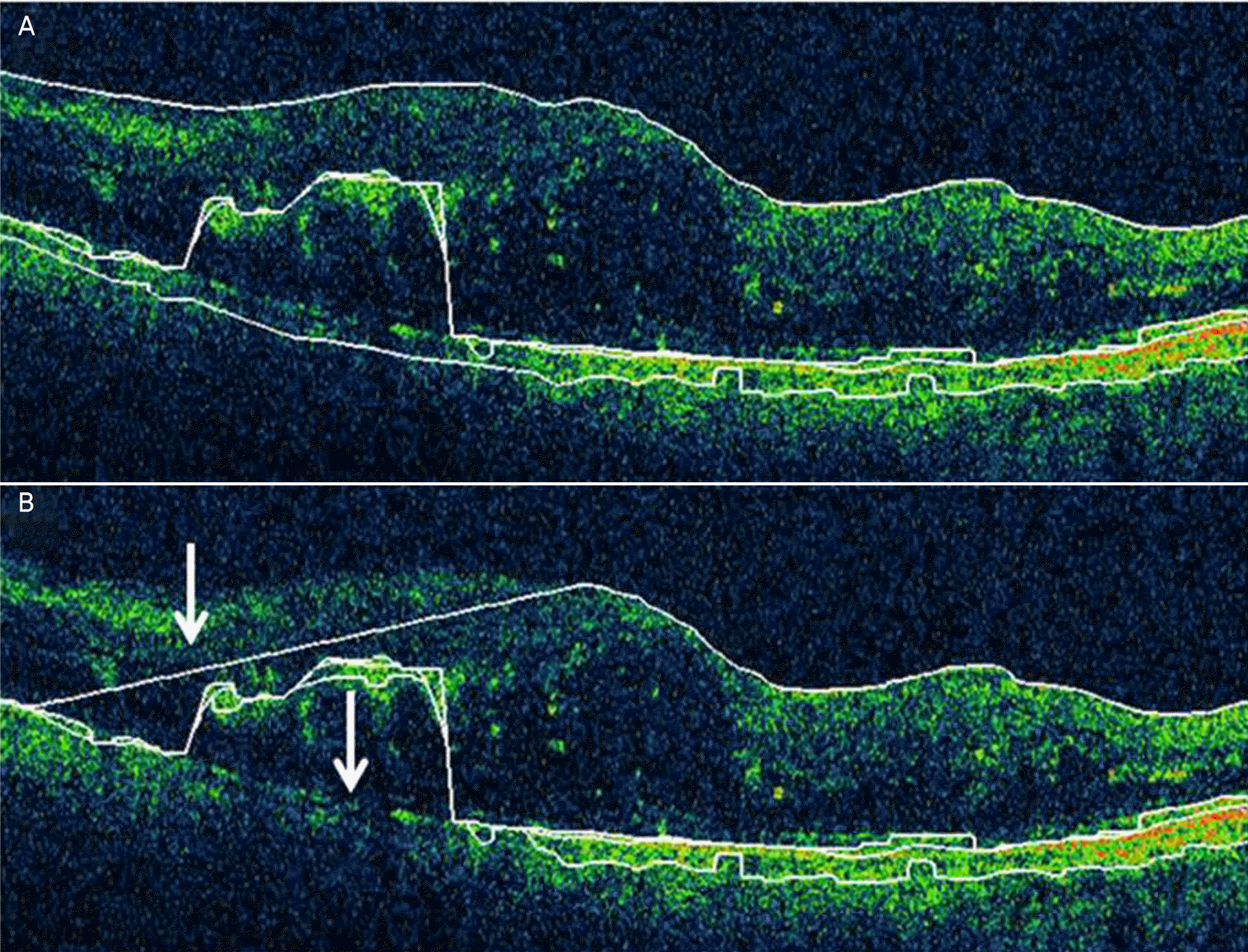Abstract
Purpose
To evaluate the repeatability of macular thickness and total macular volume measurements made using spectral domain optical coherence tomography (OCT) in normal subjects and subjects with macular disease.
Methods
Among a total of 108 subjects, there were 50 normal subjucts, 20 patients with diabetic macular edema, 10 patients with retinal vein occlusion, 15 patients with age-related macular degeneration, and 13 subjects with other conditions. Two serial macular measurements were obtained from each subject by a single experienced examiner using spectral domain OCT. The repeatability of the measurements was evaluated by comparing two consecutive foveal and perifoveal thickness measurements and total macular volume measurements. The intraclass correlation coefficient was also calculated to evaluate the repeatability of measurements made in normal and macular disease subjects.
Result
Spectral domain OCT measurements of macular thickness and macular volume were found to be consistent. Measurements of normal subjects were the most consistent, followed by measurements of patients with age-related macular degeneration, retinal vein occlusion, and diabetic macular edema.
Conclusions
Although measurements made using spectral domain OCT were repeatable across all subjects, they were more consistent in normal subjects than in patients with macular disease. The differences in repeatability should be considered in the context of diseased pathologic anatomy. Physicians should remain cautious when using these measurements for clinical evaluation.
References
1. Bruce A, Pacey E, Dharni P, et al. Repeatability and abdominal of macular thickness measurements using Fourier domain optical coherence tomography. Open Ophthalmol J. 2009; 3:10–4.
2. Vizzeri G, Weinreb RN, Gonzalez-Garcia AO, et al. Agreement between spectraldomain and time-domain OCT for measuring RNFL thickness. Br J Ophthalmol. 2009; 93:775–81.

3. Patel PJ, Chen FK, Ikeji F, et al. Repeatability of Stratus optical abdominal tomography measures in neovascular age-related macular degeneration. Invest Ophthalmol Vis Sci. 2008; 49:1084–8.
4. Han IC, Jaffe GJ. Comparison of specrtral and time domain abdominal coherence tomography for retinal thickness measurements in healthy and diseased eye. Am J Ophthalmol. 2009; 147:847–58.
5. Menke MN, Dabov S, Knecht P, et al. Reproducibility of retinal thickness measurements in healthy subjects using spectralis abdominal coherence tomography. Am J Ophthalmol. 2009; 147:467–72.
6. Gupta V, Gupta P, Singh R, et al. Spectral-domain Cirrus high-definition optical coherence tomography is better than time-abdominal Stratus optical coherence tomography for evaluation of abdominal pathologic features in uveitis. Am J Ophthalmol. 2008; 145:1018–22.
7. Leunq CK, Cheung CY, Weinreb RN, et al. Comparison of abdominal thickness measurements between time domain and spectral domain optical coherence tomography. Invest Ophthalmol Vis Sci. 2008; 49:4893–7.
8. Yi K, Mujat M, Chen TC. Spectral domain optical coherence abdominal for quantitative evaluation of drusen and associated structural changes in non-neovascular age-related macular degeneration. Br J Ophthalmol. 2009; 93:176–81.
9. Oh SB, Cho WB, Moon JW, Kim HC. Repeatability and abdominal of macular thickness measurement using time domain OCT and spectral domain OCT in normal subjects. J Korean Ophthalmol Soc. 2009; 50:710–6.
10. Bland JM, Altman DG. Statistical methods for assessing abdominal between two methods of measurement. Lancet. 1986; 1:307–10.
11. Polito A, Del borrello M, Isola M, et al. Repeatability and Reproducibility of Fast Macular Thickness Mapping With Stratus Optical Coherence Tomography. Arch Ophthalmol. 2005; 123:1330–7.

12. Tatlipinar S, Shah SM, Campochiaro PA, et al. Intraobserver abdominal of automated versus adjusted optical coherence abdominal measurements in patients with neovascular age-related abdominal degeneration. Ophthalmologica. 2007; 221:227–32.
13. Forooghian F, Cukras C, Meyerle CB, et al. Evaluation of time domain and spectral domain optical coherence tomography in the measurement of diabetic macular edema. Invest Ophthalmol Vis Sci. 2008; 49:4290–6.

14. Benson SE, Schlottmann PG, Bunce C, et al. Assessment of the re-probucibility of a method of grading macular subretinal fluid abdominal optical coherence tomography. Eye. 2006; 20:1030–3.
15. Diabetic Retinopathy Clinical Research Network. Reproducibility of macular thickness and volume using Zeiss optical coherence abdominal in patients with diabetic macular edema. Ophthalmology. 2007; 114:1520–5.
16. Costa RA. Evaluation of image artifact produced by optical abdominal tomography of retinal pathology. Am J Ophthalmol. 2005; 139:18–29.
17. Sadda SR, Wu Z, Walsh AC, et al. Errors in retinal thickness abdominals obtained by optical coherence tomography. Ophthalmology. 2006; 113:285–93.
Figure 1.
A. First scanned image of a patient with age-related macular degeneration is obtained by spectral domain optical coherence tomography (OCT). B. Second scanned image from same patient of image A shows white arrows indicating the difference in outer segmentation between two repeated images. Subretinal lesion might affect retinal pigment epithelium complex segmentation algorithm of spectral domain OCT. These errors would let down reliability of measurements than normal subjects.

Figure 2.
A is first capture of optical coherence tomography (OCT) image and B is second OCT image in branched retinal vein occlusion (BRVO) case. There were inner segmentation errors. Low reflectivity of the internal limiting membrane might cause this difference. Especially, intraretinal edema related diseases such as diabetic macular edema and BRVO have more inner segmentation errors. Inner segmentation errors could cause larger difference in macular thickness measurement than outer segmentation errors. Because, the vertical width of inner retina which inner segmentation error could happen was larger than width of RPE complex which outer segmentation error could happen. By all means, BRVO group had lower intraclass correlation coefficient than age-related macular degeneration.

Figure 3.
A is first capture of optical coherence tomography (OCT) image and B is second OCT image of diabetic macular edema (DME) case. Because macular edema makes lower reflectivity of internal limiting membrane, inner segmentation errors might affect repeatability in macular thickness measurement. Furthermore, intraretinal lesions like hard exudates disturb outer segmentation algorithm. So, inner and outer segmentation errors happened simultaneously. These errors are considered to make low intraclass correlation coefficient in DME group.

Table 1.
Mean values of foveal, perifoveal thickness and total macular volume
Table 2.
Comparison of two repeated measurements of macular thickness and total macular volume in each groups (P-value analyzed by paired T-test)
Table 3.
Intraclass correlation coefficient (ICC) and coefficient of variation(COV) of macular thickness measurements
| ICC* | COV | |
|---|---|---|
| Normal | 0.945 | 7.8% |
| DME† | 0.661 | 16.4% |
| RVO‡ | 0.774 | 13.5% |
| ARMD§ | 0.804 | 11.2% |
| Others | 0.856 | 10.6% |
Table 4.
Frequency of outer, inner, and both segmentation errors
| Any segmentation error | Outer segmentation error | r Inner segmentation error | Both segmentation error | |
|---|---|---|---|---|
| Normal(50 eyes) | 2(4%) | 2(4%) | 0 | 0 |
| DME*(20 eyes) | 11(55%) | 0 | 4(20%) | 7(35%) |
| RVO†(10 eyes) | 5(50%) | 0 | 5(50%) | 0 |
| ARMD‡(15 eyes) | 6(40%) | 5(33%) | 1(6%) | 0 |
| Others(13 eyes) | 2(15%) | 2(15%) | 0 | 0 |




 PDF
PDF ePub
ePub Citation
Citation Print
Print


 XML Download
XML Download